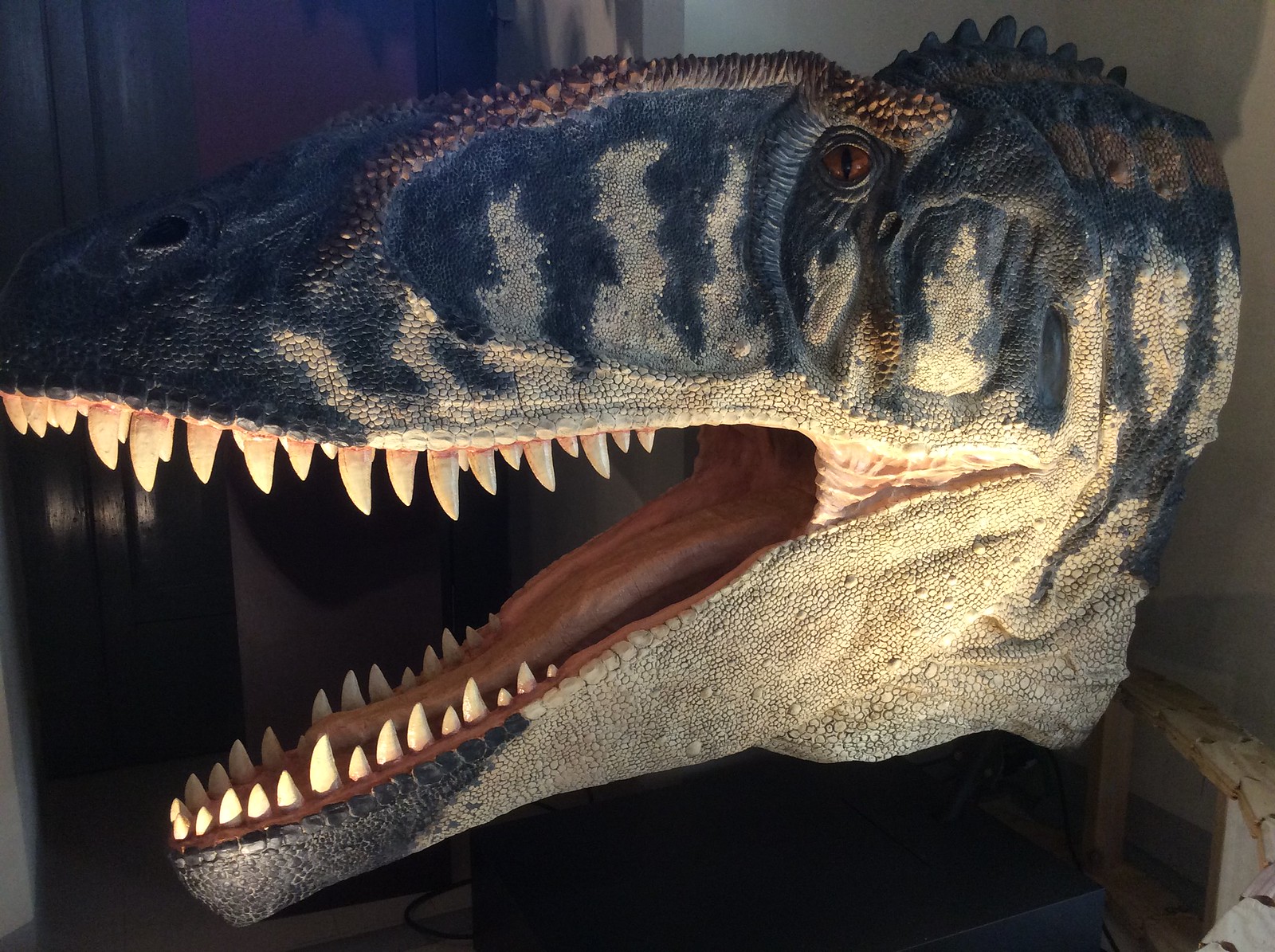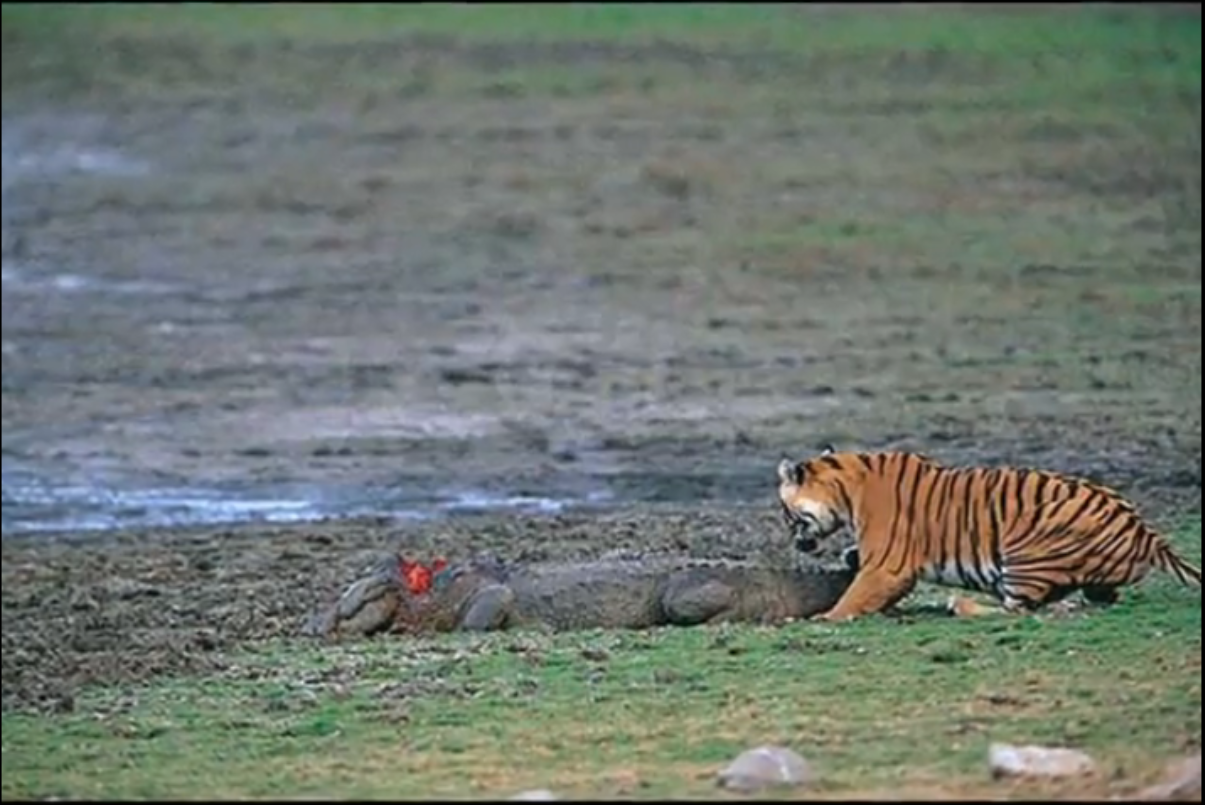Post by DinosaurMichael on Nov 30, 2013 19:20:36 GMT 5
Bengal Tiger - Panthera tigris tigris
The Bengal tiger (Panthera tigris tigris) is a tiger subspecies native to the Indian subcontinent that in 2010 has been classified as endangered by IUCN. The total population is estimated at fewer than 2,500 individuals with a decreasing trend, and none of the Tiger Conservation Landscapes within the Bengal tiger's range is large enough to support an effective population size of 250 adult individuals. The Bengal tiger is the most numerous tiger subspecies with populations estimated at 1,520–1,909 in India, 440 in Bangladesh, 124–229 in Nepal and 67–81 in Bhutan. Bengal is traditionally fixed as the typical locality for the binomial Panthera tigris, to which the British taxonomist Reginald Innes Pocock subordinated the Bengal tiger in 1929 under the trinomial Panthera tigris tigris. The Bengal tiger's coat is yellow to light orange, with stripes ranging from dark brown to black; the belly and the interior parts of the limbs is white, and the tail is white with black rings. Male Bengal tigers had a total length, including the tail, from 270 to 310 cm (110 to 120 in), while females range from 240 to 265 cm (94 to 104 in). Tails are 85 to 110 cm (33 to 43 in) long, and height at the shoulders is 90 to 110 cm (35 to 43 in). The head and body length of three males captured in Nagarahole National Park ranged from 189 to 204 cm (74 to 80 in), with a tail length of 100 to 107 cm (39 to 42 in), while a single female measured 161 cm (63 in), with a tail length of 87 cm (34 in). The average weight of males is 221.2 kg (488 lb), while that of females is 139.7 kg (308 lb). Males captured in Chitwan National Park in the early 1970s had an average weight of 235 kg (520 lb) ranging from 200 to 261 kg (440 to 580 lb), and that of the females was 140 kg (310 lb) ranging from 116 to 164 kg (260 to 360 lb). Males from the northern India are as large as Siberian tigers with a greatest length of skull of 332 to 376 mm (13.1 to 14.8 in). The tiger in India has no definite mating and birth seasons. Most young are born in December and April. Young have also been found in March, May, October and November. In the 1960s, certain aspects of tiger behaviour at Kanha National Park indicated that the peak of sexual activity was from November to about February, with some mating probably occurring throughout the year.

Postosuchus - Postosuchus kirkpatricki
Postosuchus, meaning "crocodile from Post (Garza, Texas)", was a basal archosaur that lived in what is now North America during the middle through to the late Triassic period (228-202 million years ago). It was a rauisuchian, a close relative of crocodiles, as a member of the clade Pseudosuchia (or Crurotarsi) which, along with the lineage that led to dinosaurs and Birds, forms Archosauria. Its name refers to Post Quarry, a place in Texas where many fossils of this genus were found. It was one of the apex predators of its area during the Triassic, larger than the small dinosaur predators of its time (such as Coelophysis). It was a hunter which probably preyed on dicynodonts and many other creatures smaller than itself. Postosuchus was a quadrupedal reptile with a wide skull and a long tail. This carnivore attacked with its large curved claws. It was about 4–5 meters long (12–15 feet), and was held up by columnar legs (a quite uncommon feature in reptiles). A crocodile-like snout, filled with many large-sized dagger-like teeth, was used to kill its prey. Rows of protective plates covering its back formed a defensive shield. Postosuchus was one of the largest carnivorous reptiles during the late Triassic, reaching up to 4 meters (13 ft) in length and 2 meters (6.5 ft) in height. In life the animal would weigh about 250 to 300 kilograms (550lb to 660lb). It had a massively built skull bearing dagger-like teeth. The neck was elongated, expanding to a short torso and long tail. Each one of Postosuchus's two forelimbs was slightly over half the size of the hindlimbs. This characteristic of short forelimbs can usually be seen in bipedal reptiles. Chatterjee suggested that Postosuchus could walk in an erect stance, since the short forelimbs were probably used only during slow locomotion. However, in 1995 Long and Murry stated that Postosuchus was heavily built and quadrupedal. There is debate over whether Postosuchus was bipedal or quadrupedal and scientists aren't certain, yet, about its gait. However, it has also been suggested by some palaeontologists that Postosuchus might possibly have been a facultative biped, meaning that it alternated between walking bipedally, occasionally, and quadrupedally.

The Bengal tiger (Panthera tigris tigris) is a tiger subspecies native to the Indian subcontinent that in 2010 has been classified as endangered by IUCN. The total population is estimated at fewer than 2,500 individuals with a decreasing trend, and none of the Tiger Conservation Landscapes within the Bengal tiger's range is large enough to support an effective population size of 250 adult individuals. The Bengal tiger is the most numerous tiger subspecies with populations estimated at 1,520–1,909 in India, 440 in Bangladesh, 124–229 in Nepal and 67–81 in Bhutan. Bengal is traditionally fixed as the typical locality for the binomial Panthera tigris, to which the British taxonomist Reginald Innes Pocock subordinated the Bengal tiger in 1929 under the trinomial Panthera tigris tigris. The Bengal tiger's coat is yellow to light orange, with stripes ranging from dark brown to black; the belly and the interior parts of the limbs is white, and the tail is white with black rings. Male Bengal tigers had a total length, including the tail, from 270 to 310 cm (110 to 120 in), while females range from 240 to 265 cm (94 to 104 in). Tails are 85 to 110 cm (33 to 43 in) long, and height at the shoulders is 90 to 110 cm (35 to 43 in). The head and body length of three males captured in Nagarahole National Park ranged from 189 to 204 cm (74 to 80 in), with a tail length of 100 to 107 cm (39 to 42 in), while a single female measured 161 cm (63 in), with a tail length of 87 cm (34 in). The average weight of males is 221.2 kg (488 lb), while that of females is 139.7 kg (308 lb). Males captured in Chitwan National Park in the early 1970s had an average weight of 235 kg (520 lb) ranging from 200 to 261 kg (440 to 580 lb), and that of the females was 140 kg (310 lb) ranging from 116 to 164 kg (260 to 360 lb). Males from the northern India are as large as Siberian tigers with a greatest length of skull of 332 to 376 mm (13.1 to 14.8 in). The tiger in India has no definite mating and birth seasons. Most young are born in December and April. Young have also been found in March, May, October and November. In the 1960s, certain aspects of tiger behaviour at Kanha National Park indicated that the peak of sexual activity was from November to about February, with some mating probably occurring throughout the year.

Postosuchus - Postosuchus kirkpatricki
Postosuchus, meaning "crocodile from Post (Garza, Texas)", was a basal archosaur that lived in what is now North America during the middle through to the late Triassic period (228-202 million years ago). It was a rauisuchian, a close relative of crocodiles, as a member of the clade Pseudosuchia (or Crurotarsi) which, along with the lineage that led to dinosaurs and Birds, forms Archosauria. Its name refers to Post Quarry, a place in Texas where many fossils of this genus were found. It was one of the apex predators of its area during the Triassic, larger than the small dinosaur predators of its time (such as Coelophysis). It was a hunter which probably preyed on dicynodonts and many other creatures smaller than itself. Postosuchus was a quadrupedal reptile with a wide skull and a long tail. This carnivore attacked with its large curved claws. It was about 4–5 meters long (12–15 feet), and was held up by columnar legs (a quite uncommon feature in reptiles). A crocodile-like snout, filled with many large-sized dagger-like teeth, was used to kill its prey. Rows of protective plates covering its back formed a defensive shield. Postosuchus was one of the largest carnivorous reptiles during the late Triassic, reaching up to 4 meters (13 ft) in length and 2 meters (6.5 ft) in height. In life the animal would weigh about 250 to 300 kilograms (550lb to 660lb). It had a massively built skull bearing dagger-like teeth. The neck was elongated, expanding to a short torso and long tail. Each one of Postosuchus's two forelimbs was slightly over half the size of the hindlimbs. This characteristic of short forelimbs can usually be seen in bipedal reptiles. Chatterjee suggested that Postosuchus could walk in an erect stance, since the short forelimbs were probably used only during slow locomotion. However, in 1995 Long and Murry stated that Postosuchus was heavily built and quadrupedal. There is debate over whether Postosuchus was bipedal or quadrupedal and scientists aren't certain, yet, about its gait. However, it has also been suggested by some palaeontologists that Postosuchus might possibly have been a facultative biped, meaning that it alternated between walking bipedally, occasionally, and quadrupedally.




















